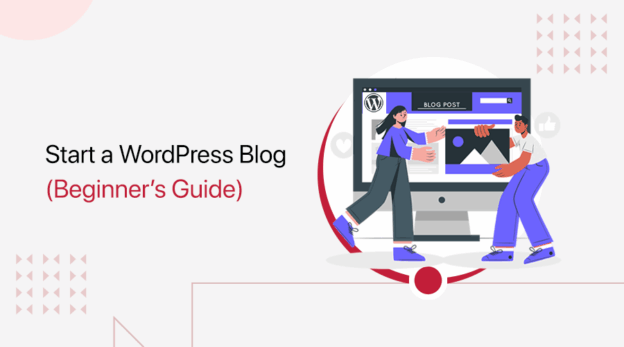Starting a blog with WordPress is one of the easiest and most effective ways to build an online presence, share your knowledge, or even create a source of income.
WordPress powers more than 40% of all websites worldwide, which makes it the most trusted platform for bloggers and businesses alike.
The best part? You don’t need advanced technical skills. With the right guidance, you can have a professional blog up and running in less than a day. This comprehensive guide will show you exactly how to start a WordPress blog step by step.
Contents
- 1 Step 1: Decide on Your Blog Niche
- 2 Step 2: Get a Domain Name and Hosting
- 3 Step 3: Install WordPress
- 4 Step 4: Choose a Theme for Your Blog
- 5 Step 5: Install Essential Plugins
- 6 Step 6: Set Up Important Pages
- 7 Step 7: Write and Publish Your First Blog Post
- 8 Step 8: Optimize Your Blog for SEO
- 9 Step 9: Promote Your Blog
- 10 Step 10: Monetize Your Blog
- 11 FAQ
- 12 Related Posts
Step 1: Decide on Your Blog Niche
Your niche is the main topic you’ll write about. Choosing a niche helps you focus your content and attract the right audience.
Tips for picking a niche:
-
Choose something you’re passionate about.
-
Make sure there’s an audience searching for it (check with Google Trends or keyword research).
-
Focus on a niche you can write about consistently.
Popular blog niches in Canada:
-
Lifestyle and wellness
-
Food and recipes
-
Travel and outdoor activities
-
Finance and investing
-
Parenting and education
Step 2: Get a Domain Name and Hosting
Your domain name is your blog’s address (like myblog.com), while hosting is where your website files live.
How to choose a domain name:
-
Keep it short and easy to remember.
-
Avoid numbers and hyphens.
-
Use a
.comextension if possible, but.cais also great if you’re targeting Canada.
Beginner-friendly hosting providers:
-
Bluehost – officially recommended by WordPress.
-
Hostinger – affordable and reliable.
-
SiteGround – known for excellent speed and support.
Most hosting services include a free domain name for the first year.
Step 3: Install WordPress
After purchasing hosting, you can install WordPress with just one click.
Steps:
-
Log in to your hosting account.
-
Find the “WordPress” installation option.
-
Follow the instructions and choose your domain.
-
Set up your username and password.
Now you can log in to your WordPress dashboard at:yourdomain.com/wp-admin
Step 4: Choose a Theme for Your Blog
Your theme controls the look and feel of your blog. Beginners can start with free, customizable themes.
Recommended free themes for beginners:
-
Astra
-
Neve
-
OceanWP
-
GeneratePress
-
Blocksy
You can install a theme from your WordPress dashboard:
Appearance > Themes > Add New > Search & Install
Step 5: Install Essential Plugins
Plugins are like apps for your WordPress blog. They add new features without coding.
Must-have plugins for beginners:
-
Yoast SEO or Rank Math → for search engine optimization.
-
Elementor → drag-and-drop page builder.
-
WPForms → create contact forms easily.
-
UpdraftPlus → backup your site.
-
LiteSpeed Cache or W3 Total Cache → improve website speed.
Step 6: Set Up Important Pages
Before you start publishing blog posts, create these essential pages:
-
Home Page – introduce your blog.
-
About Page – tell readers who you are and why you blog.
-
Contact Page – let visitors reach you via forms or email.
-
Privacy Policy & Disclaimer – required for legal and trust reasons.
Step 7: Write and Publish Your First Blog Post
Go to Posts > Add New in your dashboard to start writing.
Beginner tips for writing your first blog post:
-
Use a clear title with a main keyword.
-
Write short paragraphs for better readability.
-
Add images to break up text.
-
Use headings (H2, H3) for structure.
Step 8: Optimize Your Blog for SEO
SEO (Search Engine Optimization) helps your blog rank higher on Google.
Basic SEO tips for beginners:
-
Use keywords naturally in your content.
-
Add meta titles and descriptions with Yoast or Rank Math.
-
Optimize images (compress them before uploading).
-
Make your site mobile-friendly.
-
Improve loading speed with a caching plugin.
Step 9: Promote Your Blog
Writing content is just the beginning. You need to promote your blog to get readers.
Promotion strategies:
-
Share posts on social media (Facebook, Twitter, Pinterest, LinkedIn).
-
Join online forums and communities in your niche.
-
Build an email list with a free tool like Mailchimp.
-
Network with other bloggers through guest posts and collaborations.
Step 10: Monetize Your Blog
Once you build traffic, you can earn money from your blog.
Ways to monetize:
-
Ads – sign up for Google AdSense or Mediavine.
-
Affiliate marketing – recommend products and earn commission.
-
Sponsored posts – brands pay you to write content.
-
Digital products – sell eBooks, courses, or templates.
-
Freelance services – offer writing, design, or consulting.
FAQ
Q: How much does it cost to start a WordPress blog?
On average, it costs between $50–$100 per year for hosting and a domain.
Q: Do I need coding skills to use WordPress?
No. WordPress is beginner-friendly, and most customizations can be done without coding.
Q: Can I change my theme later?
Yes. You can switch themes anytime, though you may need to re-adjust some design settings.
Q: How long does it take to build a blog?
With a step-by-step approach, you can launch a blog in less than one day.
Q: Is WordPress better than free blogging platforms?
Yes. A self-hosted WordPress blog gives you full control, better SEO, and monetization options.
